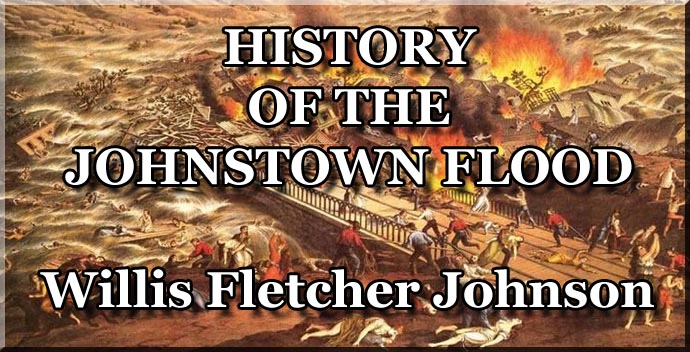
History of the Johnstown Flood
By Willis Fletcher Johnson
Chapter 43
|
Dynamite was one of the most effective agencies resorted to in clearing up the ruins. In places there were vast masses of wreckage, which it would have been the labor of months to clear away by ordinary means. But dynamite cartridges wee exploded, shattering the masses so that they could readily be displaced. Sometimes the effect of these blasts was indescribably horrible. Unwittingly they would be placed close by a number of undiscovered corpses, and upon their explosion the air would be filled with arms and legs and shreds of human bodies – a sight sufficient to make the bravest and sternest turn away, sickened and revolting. At one time one hundred and fifty cartridges were exploded at once in the great drift at the stone bridge, and the noise could be heard for miles. On June 15th the great mass was finally broken up. Six acres of solidly packed wreckage wedged between the river banks by a hydraulic force that cannot be estimated had in three days melted away. Large frame houses, hundreds of logs, and monster trees were tangled up and bound together with wire and iron bars brought down with the flood. The scene when the great mass moved down the river was a remarkable one. The crowds that lined the shores and the now famous stone bridge raised a shout that was heard the length and breadth of the valley. Nor was the use of these powerful charges of dynamite without some ill effect. Charges of four hundred and five hundred pounds each frightened the town and shook the houses. Half of the windows in the Millvale school-house were shattered, and on Prospect Hill, just opposite, the chimneys came rattling down upon the house-tops. The town was soon in a state of nervous terror. General Manager John Fulton, of the Cambria Iron Company, dictated a forcible protest to Governor Beaver, saying that the mills and offices of the company were being ruined by the blasts; that General Hastings had paid no attention to two requests for its discontinuance, and that the State would be held responsible for any further damage done. The message was filed in the telegraph office, with instructions that it be put upon the wire as soon as another blast was fired. In the meantime General Hastings had gained communication with Major Phillips, and an order to discontinue the blasting went into effect. The message did not go to the Governor, but General Manager showed it to the Associated Press representative, and said: “I do not hold General Hastings responsible for dynamiting. It is the height of nonsense, however, to fire such heavy blasts so near valuable buildings. My superintendent reports that the damp walls of the mills are giving way under the shocks, and here in my own office the ceiling has opened a quarter of an inch within the past three hours. Buildings in Johnstown are in too delicate a condition to be trifled with by dynamiters.” Major Phillips has been engaged in blowing out the wreckage in the channel of the Conemaugh above the Pennsylvania Railroad stone bridge. He was anxious to have a passage for the water, and to that end put in a five-hundred-pound blast of dynamite. The blast was placed under two buildings, one of which was lying upon the other, and both of them covered with logs. The explosion was terrific, and one log large enough for a mainmast, was hurled three hundred feet in the air. The next blast not being placed so deep was a four-hundred pounder. This one did all the damage. The report was awful, and the strongest houses in the city trembled like leaves. All the glass was blown out of the windows of Odd Fellows' Hall, which seems to have stood over a stratum of unusual disturbance. In the same neighborhood the rear wall of the half-wrecked Catholic church which fell upon the Baltimore and Ohio tracks, blocking them. Chimneys rattled down all about, and dishes were broken in houses in Kernville, half a mile away.
|
|
 |
 |
|
|
|
-
Site Navigation
 Home
Home What's New
What's New Bible
Bible Photos
Photos Hiking
Hiking E-Books
E-Books Genealogy
Genealogy Profile
Free Plug-ins You May Need
Profile
Free Plug-ins You May Need
 Get Java
Get Java.png) Get Flash
Get Flash Get 7-Zip
Get 7-Zip Get Acrobat Reader
Get Acrobat Reader Get TheWORD
Get TheWORD